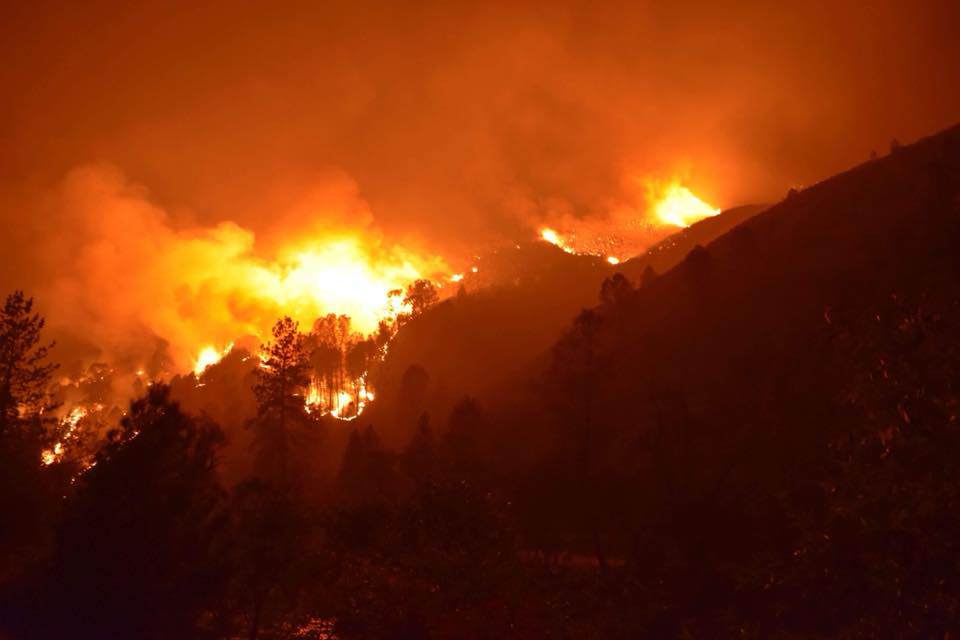
2018 Ferguson Fire in Mariposa County
Credit: Blake Scott/NPS
February 6, 2019 - By Robert Spiegel - There is great momentum from state government to find solutions to California's wildfire and forest-management crises. Two government agencies have  unveiled a plan to quicken forest management—and environmental groups quickly threatened lawsuits.
unveiled a plan to quicken forest management—and environmental groups quickly threatened lawsuits.
The California State Board of Forestry and Fire Protection and the Department of Forestry and Fire Protection—or Cal Fire—announced last week their intention to expedite forest-management projects and prescribed burns, by creating a single, streamlined environmental-review process for activities conducted on private land.
Regulatory streamlining for environmental reviews is not an entirely new concept, but it's imperative that California state agencies begin to carefully examine the current condition of our forested landscapes and move expeditiously, both to protect Californians from catastrophic wildfire and to protect our forests from further environmental damage.
Specifically, the Board of Forestry and Cal Fire will undertake the preparation of what's called a California Vegetation Treatment Program Environmental Impact Report—CalVTP for short. It should allow California to increase the pace and scale of management activities.
Vegetation management can consist of activities such as prescribed fire, mechanical and manual thinning, grazing and the targeted ground application of herbicides—all intended to alter landscape fuels and reduce the size, intensity and frequency of wildfire. Such vegetation management is a wildfire-prevention strategy that complements other fuel-reduction projects conducted by the federal government, local governments and individual Californians who practice and maintain defensible space, or who have invested financially by retrofitting their homes with more wildfire-resilient construction.
The desire of the board and Cal Fire to increase active management activities can trigger permitting requirements under the California Environmental Quality Act, but CEQA allows for preparation of programmatic environmental impact reports when a series of related actions can be characterized as one large project. These programmatic environmental reports evaluate actions that are similar due to location, timing or potential impacts that can be resolved in similar ways.
This option effectively eliminates the need for repetitive review of related actions on a project-by-project basis, while allowing comprehensive examination. It also promotes "tiering" when later activities within the program are undertaken. Tiering allows for expedited environmental review, eliminates redundant analyses of issues and impacts, reduces costs and provides regulatory certainty.
Despite those benefits, environmental groups have already expressed displeasure at the use of a CalVTP, predicting future lawsuits and claiming the plan represents nothing more than a mechanism to clear-cut California forests.
No one is talking about clear-cutting, and the board and Cal Fire have continued to move forward with the CalVTP. That's a positive development that maintains the momentum for more active management of wildland fuels within Cal Fire's State Responsibility Area—roughly 31 million acres of state and private lands.
The need for active forest management has been seen all too vividly in recent years. The 2018 California wildfire season was the deadliest and most destructive in history. The 2017 wildfire season was equally unprecedented. In these two consecutive years, California witnessed nearly 3 million acres destroyed by wildfires, billions of dollars in losses, and heartbreaking casualties—both to civilians and first responders. In fact, six of the top 10 most destructive fires in California history have occurred in just the last two years: Camp, Tubbs, Woolsey, Carr, Nuns and Thomas.
Whether we call this the "new normal" or the "new abnormal," California regulatory agencies, the Legislature and governor must take immediate, direct action in response.
The sheer magnitude of these consecutive wildfire seasons prompted the California Legislature and former Gov. Jerry Brown to enact a series of bills related to California's investor-owned utilities, wildfire and forestry.
Senate Bill 901, which passed last year, was the most comprehensive legislative proposal related to wildfire prevention, fuel reduction, forestry policies and wildfire-mitigation plans by California utility companies. SB 901 will also provide $1 billion from the state Greenhouse Gas Reduction Fund.
Earlier this year, Gov. Gavin Newsom committed to ensuring that all of the $1 billion provided by SB 901 would be allocated during the next five years, and he provided the first installment of $200 million in his 2019-20 budget proposal. This came in addition to a separate proposal from the governor that would provide more than $400 million for forest health and fire protection resources. Further, Gov. Newsom, via executive order, has required Cal Fire to identify and provide recommended actions to prevent and mitigate wildfires, not only to protect environmental sustainability but also public health and safety.
Human-caused and natural factors have combined to place California forests and wildlands in their current condition. Excessive vegetation density, an overabundance of smaller trees and underbrush, and unprecedented tree mortality will continue if we don't act to improve forest health. Decades of active management and ongoing funding will be needed to reverse problems worsened by regulatory constraints, lack of funding and decades of fire suppression.
A statewide vegetation program such as that being pursued by the Board of Forestry and Cal Fire is one tool that can ensure fuel-reduction work in California will be accomplished, and will protect lives, homes, communities and our state's environment.
(Robert Spiegel is government affairs advocate for forestry and natural resources policy for the California Farm Bureau Federation. He may be contacted at rspiegel@cfbf.com.)
Reprinted with permission: California Farm Bureau Federation








